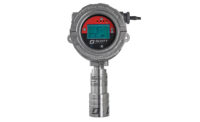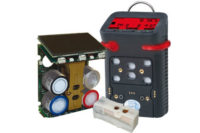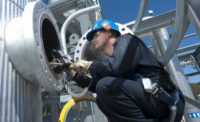Strategies for toxic gas detection
Where to set alarms during confined space procedures

Which exposure limits apply?
The most important obligation for any employer is to ensure that workers are not harmed by exposure to toxic materials or conditions that may be present in the workplace environment. Exposure limits like the OSHA PEL, NIOSH REL and ACGIH® TLV® provide exposure limits, which if exceeded, may lead to immediate or long term harm. These guidelines and standards set the limits above which conditions are deemed to be hazardous. They are not necessarily the concentrations that should be used when setting alarms. For instrument users there are two obligations. The first is ensuring that workers are not exposed to hazardous conditions. The second is ensuring that workers are able to leave the affected area before becoming affected by a hazardous condition. Workers should be out of the area before rather than after the concentration of toxic gas exceeds the hazardous condition threshold. Unfortunately, the PEL, REL and TLV® are not always in agreement. Which exposure limit is applicable and enforceable depends on where you are, what you are doing, and who is responsible for enforcing your workplace safety requirements. Even when the applicable (and enforceable) hazardous condition threshold concentrations are unambiguous, setting the alarms can still be a challenge.
OSHA regulations use the term Permissible Exposure Limit (PEL) to define the maximum concentration of a listed contaminant to which an unprotected worker may be exposed during the course of his workplace duties. OSHA PELs are listed in Subpart Z (Section 1910.1000) of the Code of Federal Regulations, and in substance-specific standards (e.g., methylene chloride, 1910.1052 and benzene, 1910.1028) and posted at www.OSHA.gov. Individual states may either follow the Federal regulations, or if they have their own “Approved Occupational Safety and Health Plan” may follow their own, state-specific permissible exposure limits. States may not publish or follow exposure limits that are more permissive than Federal OSHA limits. Twenty-five states (as well as Puerto Rico and the Virgin Islands) have their own approved plan. The exposure limits in these jurisdictions are often more conservative than the Federal OSHA PELs.
The National Institute of Occupational Safety and Health (NIOSH) develops and periodically revises recommended exposure limits (RELs) for hazardous substances or conditions in the workplace. The NIOSH REL is an occupational exposure limit that has been recommended by NIOSH to OSHA for adoption as a permissible exposure limit. The REL represents a level of exposure that NIOSH believes would be protective of worker safety and health over a working lifetime if used in combination with engineering and work practice controls. With only a few exceptions, the OSHA PELs listed in Subpart Z are the same values originally promulgated in 1971. Because NIOSH RELs are periodically reviewed and updated, they tend to be more conservative. Many states with approved occupational safety and health plans use the NIOSH RELs as the basis for their state specific permissible exposure limits. NIOSH and OSHA exposure limits are included in the "NIOSH Pocket Guide to Chemical Hazards," which can downloaded at http://www.cdc.gov/niosh/npg/
What are TLVs®, and why do they matter?
ACGIH Threshold Limit Values® are designed to function as recommendations for the control of health hazards, and to provide guidance intended for use in the practice of industrial hygiene. Although ACGIH TLVs® are not expressly developed for use as legal standards; they are often incorporated by reference into state, federal, and many international regulations governing workplace exposure. They may also be cited or incorporated by reference in consensus standards of associations such as the National Fire Protection Association (NFPA), or American National Standards Institute (ANSI). Given the potential for lawsuits, many employers have made the strategic decision to base their corporate health and safety programs on the most conservative applicable recognized standards. Since ACGIH recommendations are frequently more conservative than OSHA PELs and NIOSH RELs, many programs, especially the programs of multinational or prominent corporations, use the ACGIH TLVs®. ACGIH® publications may be purchased or downloaded at www.ACGIH.org
TLVs are not consensus standards. They are based on peer-reviewed toxicological and epidemiological evidence. The expense of implementing workplace controls, and the feasibility of using currently available monitoring technology are not issues central to the decision of whether or not to release or amend a TLV®. The idea is for science to speak with a neutral voice, and for employers and safety equipment manufacturers to respond as necessary to protect workers. This can create problems when there is a significant drop between the old and the new TLV®. In fact, many jurisdictions that in the past have routinely adopted or incorporated the latest edition of the TLV® as enforceable are taking a much slower approach in light of some of the most recent updates, in particular the latest TLVs® for H2S, SO2 and NO2.
Do the toxic exposure limit standards tell you where to set the alarms?
The standards do not tell you where to set the alarms. The PEL, REL and TLV® provide enforceable limits or guidance concerning the concentration above which the atmosphere is deemed to be hazardous because of the presence of a toxic contaminant. Unprotected workers should never be exposed to concentrations that exceed this threshold. The alarm settings used should allow workers to become aware and leave the affected area before the limits are exceeded. The amount of time required for workers to self-rescue or leave the affected area needs to be part of the decision making process. Since self-rescue from a confined space can be time consuming, it’s especially important that the alarms used to trigger exit procedures are set conservatively. Setting the alarms at the actual toxic exposure limit is the least conservative approach. The best practice is to set the alarms more conservatively.
Strategies for setting the alarms
Most instruments have four user adjustable alarms for each toxic sensor: “Low”, “High”, “STEL” (15-minute) and “TWA” (8 hour). The “Low” and “High” alarms are based on real-time concentration readings. The TWA and STEL are time history calculations made or projected over a specified period.
Technically, a worker can spend a full 15 minutes at the STEL concentration, or a full 8 hours at the TWA before exceeding the exposure limit. One often used method for setting the alarms is to set the “Low” or first alarm in the instrument at the TWA limit concentration, and the second or “High” alarm at the STEL. This is still the standard approach taken by instrument manufacturers and users for many common toxic gases. (Since the NIOSH REL is more conservative than the OSHA PEL for H2S, most manufacturers base their default H2S alarm settings on the NIOSH REL rather than the OSHA PEL.) The NIOSH REL for H2S consists of an 8 hour TWA limit of 10 ppm, and a 15 minute STEL limit of 15 ppm. Thus, the typical H2S alarm settings used in most instruments was (and for most users continues to be):
Low = 10.0 ppm
High = 15.0 ppm
STEL = 15.0 ppm
TWA = 10.0 ppm
The 2010 TLV® for H2S has caused much concern among instrument users. The latest 2010 TLV® for H2S is a two part definition, with an 8-hour TWA of 1.0 ppm, and a 15-minute STEL of 5.0 ppm. Many instrument users worry that setting the low alarm at 1.0 ppm TLV®-TWA could be the cause of frequent alarms due to momentary spikes above 1.0 ppm, causing workers to lose faith in the instrument, or cease taking the correct protective measures.
For instrument users who are unaffected by the new TLV®, the tendency has been to stick with the old alarm settings. For customers affected by the TLV®, many users find the following settings meet the spirit and requirements of the 2010 TLV limit:
Low = 3.0 ppm
High = 5.0 ppm
STEL = 5.0 ppm
TWA = 1.0 ppm
For most instrument users, it is the activation of the Low alarm that triggers the decision for workers to leave the confined space or affected area. It is important to set the low alarm high enough to avoid false alarms, but low enough for workers to self-rescue without exceeding the exposure limit. Because the TWA is calculated over a full 8 hour period, momentary concentrations that exceed 1.0 ppm tend to average out, and setting the TWA alarm at 1.0 ppm seldom leads to false alarms. Setting the High alarm at the STEL limit concentration of 5 ppm is equally conservative.
Conclusion
The primary concern for any employer is to ensure that workers are not exposed to hazardous conditions. For many instrument users, recent changes in TLV® guidelines may not have a mandatory effect on instrument settings or procedures. Employers whose activities or policies require conformity with TLV® exposure limit guidelines may need to evaluate their current monitoring equipment and procedures. If you do need to take action according to the new limits, the equipment is readily available.
Footnote
1 2012 TLVs® and BEIs® Based on the Documentation of the Threshold Limit Values for Chemical Substances and Physical Agents; ACGIH® Worldwide; Signature Publications; 2012; Cincinnati, OH.
Looking for a reprint of this article?
From high-res PDFs to custom plaques, order your copy today!









